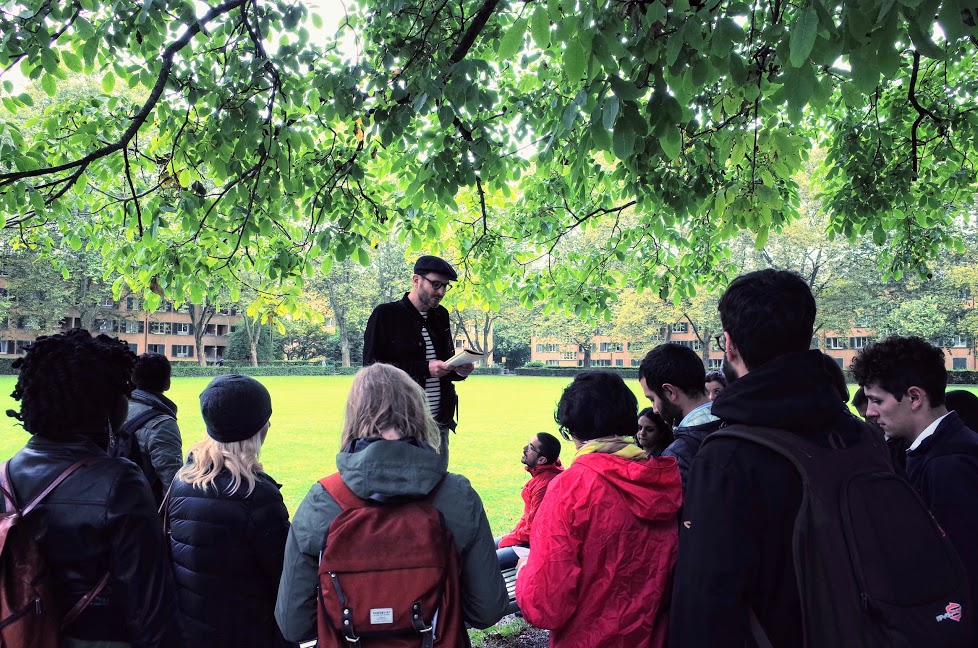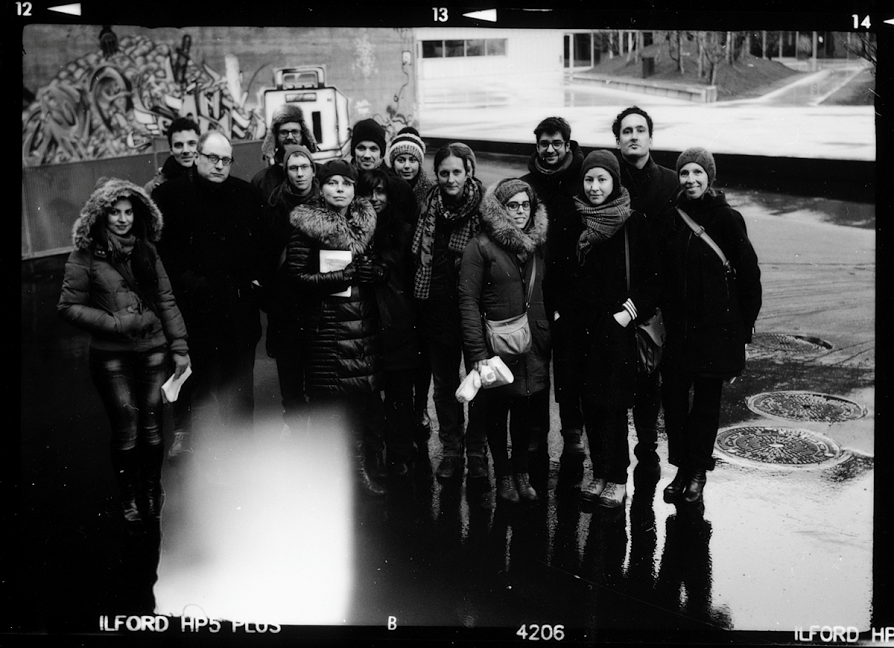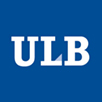
Assembling Cities Summer School guided tour. Photo: Marko Marskamp
Published in September 2017 by Palgrave Macmillan, Relational Planning: Tracing Artefacts, Agency and Practices is co-edited by 4CITIES alumni Marko Marskamp (Cohort 03) and Julio Paulos (C4), and also features a contribution by Guillén Torres (C6). The volume “builds on recent approaches to complexity and materiality in planning theory by drawing on Science and Technology Studies (STS) of urban issues. It frames planning as a socio-material practice taking place within the multifaceted relations between artefacts, agency and practices.” Field Notes recently reached out to Marko, Julio, and Guillén. Below is part two of our interview (part one was published on 21 DEC).
Q. How does relational planning address questions of agency, especially concerning the tendency of short-term political goals to trump those of long-term spatial planning?
Julio Paulos: Indeed, duration is a very sensitive topic in planning. And your question already indicates that duration has two senses, but it also brings multiple configurations. Let me rephrase, the ways in which traditions or futures intervene in planning are differential issues. It is precisely at those interfaces that conflicts are often located. ANT (Actor-Network Theory) is a particularly strong toolkit to map such controversies before they ‘black-box’ and turn into facts. I just think of the issues that could have emerged around transportation planning in the early post-war years. How expertise materialised into models. The car was central to those artefacts that thought the future of mobility as a motorised future. For this knowledge to stabilise, political discourse had to align with technical know-how. I wouldn’t blame the car industry but would call for an unravelling of these cases in terms of progressive displacements.
Marko Marskamp: Bruno Latour (1999) has an interesting piece on why the name actor-network theory misrepresents the ideas this body of work conveys. A core ANT notion is that every action is an interaction, and as such agency cannot be attributed to individual actors but only to networks (or, work-nets), which might be composed of human as well as non-human elements. Accordingly, instead of looking for the human actors in the nodes of a network, ANT looks at the heterogeneous relations that produce particular outcomes. Where planning practice still holds the ideal of a ‘master planner,’ an ANT perspective de-centers planners by seeing them as only one of many entities in a planning work-net. As a result, planning is not so much characterized by linearity and certainty as it is by complexity and contingency. When we realize this, we need to recognize too that planning objectives require constant work as issues keep coming up along the way.
In other words, we cannot fix long-terms goals at the outset since we cannot completely control all the actions within a network over an extended period of time. What we can do however, is assure that planning objectives once duly defined beyond controversy, go as long as possible ‘unquestioned.’ When and how to define and stabilize planning goals are some of the next steps in relational planning research.
Guillén Torres: The de-centering of planners that Marko mentions is, for me, one of the most interesting things that STS-influenced Urban Studies do.
“Recognizing that agency is considerably distributed in the process of planning also means that its politics get way more complicated.” (Guillén Torres)
In a way, the former also means that STS approaches have the potential to be more than shelved research and fuel political agendas.
Q. Back in 1992, Patsy Healey published the now-famous (at least in planning theory circles) article, “A planner’s day: knowledge and action in communicative practice.” How would the description of a planner’s day be different if told from a relational planning perspective?
Julio: Well, I’d say it would add other dimensions of planning to it. The thing with relational planning is that it presumes a certain non-linearity to a very linear exercise that defines the conditions for spatial (or urban) development. The planners’ tasks might have changed from back then to our current times (see the questions on democracy and participation etc.) but I believe that also back then, relational planning would rather have tried to understand the existence of things and events in planning and how those fit into the ‘whole’.
Marko: Healey’s article is one of the rare descriptions of planning practices I talked about earlier. A descriptive method is indeed in line with relational planning. The lens is different however, it does not explain planning with planning. Compared to the human (planner-) centred description of Patsy Healey, relational planning encourages a description of the many socio-material relations that make up a planning situation. As a consequence, relational planning does not assume that planning can only be explained by studying planners. As already mentioned, planners are one of many entities in a planning project network. If we want to understand urban development, for example, we might actually need to look at the plan-making activities of real estate developers and study how they mobilize planning to intervene in the built environment.
Q. Can spatial planners use the ideas in the book to improve their practice? How else can lessons from the book be applied?
Julio: They most certainly can. I believe they can use some ideas and reflect on their own practice. For this, they’d need to make the effort to bear with some academic ‘constraints’. I mean, to be honest, the volume isn’t directed to practitioners directly because it situates itself in an academic discussion. Plus, we do not assume a normative or didactic role in it. Our practical guidance is in general limited. We advance some new avenues to think with and around planning.
The lessons are encrypted in the case studies. Although they are not necessarily representative, by their own means, they come to represent a whole planning world. Be it MacMillen’s Detroit case or Farías talking about Santiago de Chile tsunami or Ola Söderström on Hanoi (and I could go on like this) each one shows how planning is being applied or circumscribed in routines and how exceptions disrupt those standards. Here lies another key aspect as to rethink planning by its capacity to follow the norm or not.
Marko: That’s a difficult one. This book is foremost intended as an intervention in an academic debate. That some of the ideas in the book have practical relevance is without a doubt.
“The question, however, is how planners (in the largest sense of the word) can turn abstract ideas and complex considerations into concrete everyday actions.” (Marko Marskamp)
I think this is a next step for us, to find ways in which these intellectually demanding insights can be introduced into the already challenging work of planners. There is definitely potential here, as Julio’s examples indicate. In my own doctoral research I explore how the experimental method can be very meaningful in rethinking the ways in which planning defines salient issues and mobilizes political will.

Broadening the concept of planners. Photo: Oliver Zenklussen
Guillén: I’d like to emphasize Marko’s broadening of the concept of planners. This book can give useful insights to anyone interested in influencing the planning process, whether they work in a planning office or not.
Q. Talk about the transition from 4CITIES to PhD. In what ways were you well prepared? In what ways not? What were the biggest challenges? The biggest discoveries? How have your perspectives on “the urban” changed?
Marko: It might sound cliché but I think 4CITIES is as much a personal experience as an academic program; you obtain a diploma and you become a 4Citizen. The program is of course very relevant for the kind of international, interdisciplinary and empirical research we do in our PhD. More importantly though, thanks to 4CITIES we learned to adapt quickly to new environments by being resourceful. Where in 4CITIES we moved from city to city and from university to university, now we travel between city administrations and international research groups. Whether studying in new places or working in new areas of research, 4CITIES teaches you to figure out where to look for answers. Whether it is a question of where to stay in the next city, who to contact for field access, or how to address a research problem, 4Citizens will find their way to an answer.
How do I now see ‘the urban’? Well that’s a controversial one. In urban studies it has been at the center of a lively debate between urban assemblages and critical urban studies. My short answer for planning studies is that, using a relational rather than a structuralist lens the urban is a certain intensity of relations.
Guillén: I (un)fortunately abandoned the Urban Studies field for my PhD. However, I’m still building upon the theoretical tools that I gathered during the masters (and my bachelor, actually). Changing fields has proven challenging (I’m now doing something somewhere at the intersection between Information Studies and Social Movement Studies), but at the same time it’s still academia, which shares a common language throughout disciplines. In that sense I feel 4CITIES prepares you well for both continuing with urban stuff or moving to something else. Something I realized I was lacking is a deeper knowledge about the ethics of research, which is now becoming a big thing throughout the world, particularly when it comes to collecting data during fieldwork. I’d seriously advise 4CITIES students to look into it!
Julio: The last point is the most interesting one to start with. My perspectives on the urban have drastically changed since 4CITIES. Or let’s say I have come to progressively sharpen my attention to objects and issues so as to multiply my appreciation for cities in many more ways then I used back then.
“When I left 4CITIES, I romanticised the urban for its rebellious capacity and broad cultural offer while criticising inequalities that structure urban existence. Now, I’ve come to believe that focussing on cities might be an act of prematurely closing certain issues.” (Julio Paulos)
Although I still believe that there is something inherently ‘urban’ to our experience, I also realised that there different approaches to composing problems. Some are located at this urban node and still captivate my interest.
4CITIES is a great program. It sparked in me the curiosity to do research and question the order of things. Plus, after all this fast living, one is definitely prepared to continue exploring (urban) life. It teaches you how to be independent, mobile and adaptive all the time. The biggest challenge: well, either you go back to your old life or you decide to keep on living 4CITIES and both routes are difficult.
Q. What’s next? Will you continue to build on the ideas found in the book, or are there other topics that now demand your attention?
Marko: In a way, our work on the book is mostly a spin-off from our research project and our respective doctoral studies. Therefore, the ideas in the book have been shaped by and continue to shape our ongoing doctoral work. In our PhD projects we use and elaborate the ideas of relational planning with respect to specific objects of study. In my case this is the planning category of ‘land use’ and the technology of land use zoning.
Julio: Difficult one. Some new projects are emerging on the horizon. I think I’ll keep doing research and keep building on relational planning. Yet I must admit, no one can predict his own trajectory.
Q. Any advice for current and future 4CITIES students?
Marko: While urban studies does not have the clear prospects of studying something like dentistry, 4CITIES does provide a personal development that will help you find your way. Although unfamiliar settings are sometimes uncomfortable, they do foster resourcefulness. In this spirit too, some 4Citizens might find the unfamiliar lens of STS intriguing and use it to think their research afresh. In any case, I think the impact of STS-inspired urban assemblages is interesting for anyone trying to understand ‘the urban.’
Guillén: Keep on rocking in the free world.
Julio: All has been said. Enjoy the freedom. Let it become a part of you. Keep exploring and never be satisfied with what you think you know.


